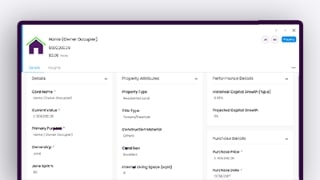About a year ago, school teacher Brendan Deith noticed there was a hole in his budget. The 40-year-old Melburnian had done $400,000 worth of renovations to the house he shares with his wife Beck and two daughters in 2021, and slowly but surely rising interest rates were beginning to hurt. His concern was that with further rate rises the family’s $700 a month surplus would degenerate into a barely break-even position. “We knew we had to come up with a plan,” Deith says. He’d been using a budgeting app to track the family’s finances since 2018 and knew they’d previously had a much healthier $2000 surplus. Deith vowed to apply more rigour to his budgeting by mapping out different financial trajectories over the course of the next year. He could see how those trajectories changed depending on how the family tweaked its spending.
Beck picked up an extra day of work, and they cut back on interstate and overseas holidays in favour of local trips. They also tweaked their spending on food, and examined their insurance, subscriptions and even petrol. The family is now saving $300 a month and has what Deith describes as a “very liveable budget”. “Slowly, slowly, slowly, as we get little bumps in our wages it’s getting easier, but we’re watching everything really closely,’” Deith says. “[In saying that], it still allows us to have some fun lifestyle things.”
All budgets come down to spending less than you earn and tracking your spending, but some styles are more rigid than others. Deith uses a pretty stringent version of the envelope, or bucketing, budgeting method (more on that below). The key to good budgeting is understanding your spending habits and being able to shift them accordingly, says Ben Kingsley, the founder of budgeting app Moorr and Managing Director at Empower Wealth.
“You want to establish some sort of rule because if you don’t have that, you’ll be all over the place,”he says.
The reason many people find budgeting tricky can be attributed to a cognitive bias that means we place more value on spending in the present than in the future, Australian National University behavioural economist Ralf Steinhauser explains. This is called time inconsistency, or present bias, and it’s one of the reasons we procrastinate. But there are biases that can help us fight back, such as loss aversion. This is the reason we feel the pain of losing something twice as keenly as the pleasure of gaining something.
Tapping into the pain of giving up on a goal, or sacrificing another area of spending, can help us stay on track. So too can mental accounting. This is a psychological process whereby we divide money into spending and saving categories in our heads. Having visualised what money is for can make it easier to resist the temptation to use it for anything else. To really hammer the point home, some people rename their savings and investment accounts to match their goals. Here are six common budgeting types.
The zero-based budget
This method involves taking your income and then assigning every single dollar a “job”. That may be bills, groceries, holiday savings and rent, but it also goes all the way down to coffees, books and Friday drinks. It suits people who have no idea where their money is going, but love control. When every dollar has a job, tradeoffs are clearly highlighted, says Steinhauser. And since everything is tracked so closely, loss aversion biases are triggered much more easily. But it takes discipline and the relentless rigidity can work against you, Steinhauser cautions. “There’s a phenomenon known as diminished sensitivity, which is that once we’ve had this feeling of a loss, the additional losses beyond that are less painful,” he says. There is also the risk that people overspend in one category and give up the budget altogether.
“You have to be willing and able to sitdown and crunch those numbers every month, and measure your actual spending versus your projected spending,” says Emma Edwards, founder of The Broke Generation financial literacy website and author of Good With Money. Users of this method need to give up some autonomy and stick to a pretty rigid spending plan. “It’s a bit of a ‘type A’ budget,” Edwards says.
The envelope (or buckets) method
This method involves grabbing a few envelopes and writing an expense category on each. Promise yourself that once the money allocated to each is gone, there are no more withdrawals to replenish the cash – until the next pay cycle, that is. These days most people will generally use digital buckets. You can choose your own buckets or envelopes, but some common categories are savings, groceries, clothing, debt and entertainment.
This method will help if you’re a spontaneous spender, but you’d like a nice mix of structure and freedom in how you choose to allocate your fun money on a month-to-month basis. This is a less intense version of the zero based budget. “The buckets are really good because they teach you to spread your money out, which is going to be really good for people who do well with structure,” Edwards says.
“This is good for reducing the mental load of your money. Keeping all your money in one account can be very heavy on the brain, and it can be difficult to do your number crunching in one place.”
If you’re a spontaneous spender, this is likely a good system for you because it traps your savings away from you, and, like the zero-based strategy, triggers that pain of making trade-offs when you go over budget, or risk maxing out a category, Empower Wealth’s Kingsley says. If those golf clubs you’ve been coveting are well beyond what you have in your leisure bucket, will you really be comfortable pulling cash from the bucket labelled ‘kids’ Christmas present savings”?
The kakeibo method
The kakeibo method involves using a journal to log all of your spending and income. Spending is split between four categories: needs, wants, culture and unexpected. Kakeibo translates from Japanese to ‘household financial ledger’, and the appeal of this method is that it focuses the mind on where money is going.
At the end of the month, you can review your journal to see if you’re made progress on savings goals. Wants are things like travel, clothing and dining out that aren’t essentials. The culture category is designed to cultivate the idea that some spending on experiences, rather than physical goods, can contribute to quality of life, wellbeing and learning. And critically, having “unexpected” as a category means you are more likely to pick up on the number of expenses that crop up out of the blue, and can help train your budget to accommodate them.
“The idea is you’re differentiating between different types of ‘wants’,” Edwards says. “Psychologically, this one is good for people who might keep a to-do list or a calendar, or who really like to journal”
The ‘pay yourself first’ method
Arguably the simplest budgeting strategy, ‘pay yourself first’ is also known as reverse budgeting. It involves setting up an instant transfer to your savings account for the day you get aid. The idea is to immediately add to your savings account, and perhaps your investment account, and then the rest of the money must cover all other expenses.
This budget is arguably the one with the least rules and works best for people who are already more inclined to save, and understand what their spending looks like. For example, you might know that $400 a week would cover $200 in groceries, a night out and some coffees and treats along the way, but it won’t stretch to cover a visit to the hairdresser or your energy bill coming through. If you can’t say what $400 a week looks like for you, then you probably need a more granular budget.
The snowball method
You might have heard of the snowball method for paying off debts, which involves listing all of your debts and paying them off from smallest to largest. When it comes to budgeting, the snowball method involves analysing the last month of spending and identifying areas you can cut back. Based on that, you set a target savings amount for that month.
Once you’ve achieved that, you take another look at your spending and see what else you can cut back on the following month. Repeat this until you’ve reached your desired savings goal. It may not lead to big changes at once, but can add up to seriously better spending habits over time.
Steinhauser says this is a good strategy if you suspect you’ve got too many direct debits and subscriptions.”Often there are things on your credit card and spending you don’t remember – you might remember you signed up to Netflix, but you might have forgotten you signed up to Amazon and Audible,” he says.
“Part of the psychology of those companies is to get people to sign up to a regular spending plan, because people often forget and don’t use it. So this is huge for being able to catch that.”
The 50:30:20 method
The classic 50:30:20 method is a much simpler strategy than the envelope or zero-based budget. It dictates you spend 50 per cent of your income on needs, 30 per cent on discretionary items, and 20 per cent on savings. Kingsley says he hasn’t seen this budget work for anyone aged in their 30s or above. “This is something I’d be thinking about if I was quite young or have just started working because it’s just building up that concept of regularly contributing to savings,” he says. And unless you tweak the percentages significantly, it’s likely not applicable to people living in expensive areas, or single parents. But if the simplicity of this structure appeals to you, Edwards suggests starting out with three categories of spending, then setting a spending limit for each.
After a month, monitor how well you’re sticking to the limit and maybe make some adjustments. To be good at this one, says Steinhauser, you also need to be sure you’re not the sort of person who will blow the 30 per cent discretionary spend on the first day. If that’s you, then it may be worth switching to a bucket or zerobased strategy to stay focused on the trade-offs. Steinhauser adds that this is likely an easier strategy than committing to a complete budget overhaul.
This article was featured on AFR by Lucy Dean on 8 October 2024 here >











